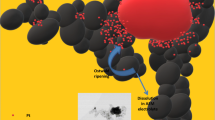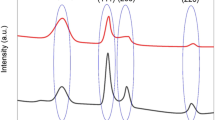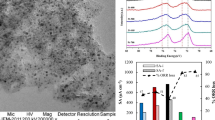Abstract
A Pd-Cu catalyst, with primary B2-type phase, supported by VulcanXC-7R carbon was synthesized via a solvothermal method. The catalysts were physically and electrochemically characterized by X-ray diffraction (XRD), X-ray photoelectron spectroscopy (XPS), transmission electron microscopy (TEM) and both cyclic and linear sweep voltammetry using a rotating disk electrode (RDE). During the RDE testing, the half-wave potential of the Pd-Cu/Vulcan catalyst was 50 mV higher compared to that of commercial Pt/C catalyst for the oxygen reduction reaction (ORR) in alkaline media. The Pd-Cu/Vulcan exhibited a specific activity of 1.27 mA/cm2 and a mass activity of 0.59 A/mgPd at 0.9 V, which were 4 and 3 times greater than that of the commercial Pt/C catalyst, respectively. The Pd-Cu/Vulcan catalyst also showed higher in-situ alkaline exchange membrane fuel cell (AEMFC) performance, with operating power densities of 1100 MW/cm2 operating on H2/O2 and 700 MW/cm2 operating on H2/Air (CO2-free), which were markedly higher than those of the commercial Pt/C. The Pd-Cu/Vulcan catalyst also exhibited high stability during a short-term, in-situ AEMFC durability test, with only around 11% performance loss after 30 hours of operation, an improvement over most AEMFCs reported in the literature to date.
Similar content being viewed by others
References
Zhang H, Shen P K. Recent development of polymer electrolyte membranes for fuel cells. Chemical Reviews, 2012, 112(5): 2780–2832
Service R F. Full cells: shrinking fuel cells promise power in your pocket. Science, 2002, 296(5571): 1222–1224
Li X, Popov B N, Kawahara T, Yanagi H. Non-precious metal catalysts synthesized from precursors of carbon, nitrogen, and transition metal for oxygen reduction in alkaline fuel cells. Journal of Power Sources, 2011, 196(4): 1717–1722
Shao M. Palladium-based electrocatalysts for hydrogen oxidation and oxygen reduction reactions. Journal of Power Sources, 2011, 196(5): 2433–2444
Spendelow J S, Wieckowski A. Electrocatalysis of oxygen reduction and small alcohol oxidation in alkaline media. Physical Chemistry Chemical Physics Pccp, 2007, 9(21): 2654
Xin L, Zhang Z, Wang Z, Qi J, Li W. Carbon supported Ag nanoparticles as high performance cathode catalyst for H2/O2 anion exchange membrane fuel cell. Frontiers in Chemistry, 2013, 1: 16
Kruusenberg I, Matisen L, Shah Q, Kannan A M, Tammeveski K. Non-platinum cathode catalysts for alkaline membrane fuel cells. International Journal of Hydrogen Energy, 2012, 37(5): 4406–4412
Sheng W, Bivens A P, Myint M, Zhuang Z, Forest R V, Fang Q, Chen J G, Yan Y. Non-precious metal electrocatalysts with high activity for hydrogen oxidation reaction in alkaline electrolytes. Energy & Environmental Science, 2014, 7(5): 1719–1724
Lu Y, Jiang Y, Gao X, Wang X, Chen W. Strongly coupled Pd nanotetrahedron/tungsten oxide nanosheet hybrids with enhanced catalytic activity and stability as oxygen reduction electrocatalysts. Journal of the American Chemical Society, 2014, 136(33): 11687–11697
Gewirth A A, Thorum M S. Electroreduction of dioxygen for fuelcell applications: materials and challenges. Cheminform, 2010, 41(28): 3557–3566
Han B, Carlton C E, Kongkanand A, Kukreja R S, Theobald B R, Gan L. Record activity and stability of dealloyed bimetallic catalysts for proton exchange membrane fuel cells. Energy & Environmental Science, 2014, 8(1): 258–266
Huang X, Zhao Z, Cao L, Chen Y, Zhu E, Lin Z, Li M, Yan A, Zettl A, Wang Y M, Duan X, Mueller T, Huang Y. High-performance transition metal-doped Pt3Ni octahedra for oxygen reduction reaction. Science, 2015, 348(6240): 1230–1234
Chen C, Kang Y, Huo Z, Zhu Z, Huang W, Xin H L, Snyder J D, Li D, Herron J A, Mavrikakis M, Chi M, More K L, Li Y, Markovic N M, Somorjai G A, Yang P, Stamenkovic V R. Highly crystalline multimetallic nanoframes with three-dimensional electrocatalytic surfaces. Science, 2014, 343(6177): 1339–1343
Service R F. Platinum in fuel cells gets a helping hand. Science, 2007, 315(5809): 172
Liang Y, Li Y, Wang H, Zhou J, Wang J, Regier T, Dai H. Co3O4 nanocrystals on graphene as a synergistic catalyst for oxygen reduction reaction. Nature Materials, 2011, 10(10): 780–786
Peng X, Zhao S, Omasta T J, Roller JM, Mustain WE. Activity and durability of Pt-Ni nanocage electocatalysts in proton exchange membrane fuel cells. Applied Catalysis B: Environmental, 2016, 203: 927–935
Shao M H, Huang T, Liu P, Zhang J, Sasaki K, Vukmirovic M B, Adzic R R. Palladium monolayer and palladium alloy electrocatalysts for oxygen reduction. Langmuir, 2006, 22(25): 10409–10415
Neergat M, Gunasekar V, Rahul R. Carbon-supported Pd-Fe electrocatalysts for oxygen reduction reaction (ORR) and their methanol tolerance. Journal of Electroanalytical Chemistry, 2011, 658(1–2): 25–32
Wang W, Zheng D, Du C, Zou Z, Zhang X, Xia B, Yang H, Akins D L. Carbon-supported Pd-Co bimetallic nanoparticles as electrocatalysts for the oxygen reduction reaction. Journal of Power Sources, 2007, 167(2): 243–249
Yang R, Bian W, Strasser P, Toney M F. Dealloyed PdCu3 thin film electrocatalysts for oxygen reduction reaction. Journal of Power Sources, 2013, 222(2): 169–176
Wu W P, Periasamy A P, Lin G L, Shih Z Y, Chang H T. Palladium copper nanosponges for electrocatalytic reduction of oxygen and glucose detection. Journal of Materials Chemistry A, Materials for Energy and Sustainability, 2015, 3(18): 9675–9681
Jiang K, Wang P, Guo S, Zhang X, Shen X, Lu G, Su D, Huang X Q. Ordered nanoparticles hot paper ordered PdCu-based nanoparticles as bifunctional oxygen-reduction and ethanol-oxidation electrocatalysts. Angewandte Chemie, 2016, 55(31): 9030–9035
Fouda-Onana F, Bah S, Savadogo O. Palladium-copper alloys as catalysts for the oxygen reduction reaction in an acidic media I: correlation between the ORR kinetic parameters and intrinsic physical properties of the alloys. Journal of Electroanalytical Chemistry, 2009, 636(1–2): 1–9
Kariuki N N, Wang X, Mawdsley J R, Ferrandon M S, Niyogi S G, Vaughey J T, Myers D G. Colloidal synthesis and characterization of carbon-supported Pd-Cu nanoparticle oxygen reduction electrocatalysts. Chemistry of Materials, 2010, 22(14): 4144–4152
Sha Y, Yu T H, Merinov B V, Shirvanian P, Goddard W A. Mechanism for oxygen reduction reaction on Pt3Ni alloy fuel cell cathode. Journal of Physical Chemistry C, 2012, 116(40): 21334–21342
You D J, Jin S A, Lee K H, Pak C, Choi K H, Chang H. Improvement of activity for oxygen reduction reaction by decoration of Iron PdCu/C catalyst. Catalysis Today, 2012, 185(1): 138–142
Wu J, Shan S, Luo J, Joseph P, Petkov V, Zhong C J. PdCu nanoalloy electrocatalysts in oxygen reduction reaction: role of composition and phase state in catalytic synergy. Acs Applied Materials & Interfaces, 2015, 7(46): 25906–25913
Tang W, Henkelman G. Charge redistribution in core-shell nanoparticles to promote oxygen reduction. Journal of Chemical Physics, 2009, 130(19): 1–351
Mustain W E, Kepler K, Prakash J. CoPdx oxygen reduction electrocatalysts for polymer electrolyte membrane and direct methanol fuel cells. Electrochimica Acta, 2007, 52(5): 2102–2108
Nørskov J K, Rossmeisl J, Logadottir A, Lindqvist L, Lyngby D, Jo H. Origin of the overpotential for oxygen reduction at a fuel-cell cathode. Journal of Physical Chemistry B, 2004, 108(46): 17886–17892
Zhang L, Hou F, Tan Y W. Shape-tailoring of CuPd nanocrystals for enhancement of electro-catalytic activity in oxygen reduction reaction. Journal of Physical Chemistry B, 2004, 108(46): 17886–17892
Howard B H, Killmeyer R P, Rothenberger K S, Cugini A V, Morreale B D, Enick R M. Hydrogen permeance of palladium–copper alloy membranes over a wide range of temperatures and pressures. Journal of Membrane Science, 2004, 241(2): 207–218
Choi R, Jung J, Kim G, Song K, Kim Y I, Jung S C, Han Y K, Song H, Kang Y M. Ultra-low overpotential and high rate capability in Li–O2 batteries through surface atom arrangement of PdCu nanocatalysts. Energy & Environmental Science, 2014, 7(4): 1362
Yamauchi M, Abe R, Tsukuda T, Kato K, Takata M. Highly selective ammonia synthesis from nitrate with photocatalytically generated hydrogen on CuPd/TiO2. Journal of the American Chemical Society, 2011, 133(5): 1150–1152
Poynton S D, Slade R C T, Omasta T J, Mustain WE, Escudero-Cid R, Ocón P, Varcoe J R. Preparation of radiation-grafted powders for use as anion exchange ionomers in alkaline polymer electrolyte fuel cells. Journal of Materials Chemistry A, 2014, 2(14): 5124–5130
Fukuta K. Eelctrolyte materials for AMFCs and AMFC performance. Tokuyama Comporation. 2011-05-08, https://energy.gov/sites/prod/files/2014/03/f11/amfc_050811_fukuta.pdf
Ponce-González J, Whelligan D K, Wang L, Soualhi R, Wang Y, Peng Y Q, Peng H Q, Apperley D C, Sarode H N, Pandey T P, Divekar A G, Seifert S, Herring AM, Zhuang L, Varcoe J R. High performance aliphatic-heterocyclic benzyl-quaternary ammonium radiation-grafted anion-exchange membranes. Energy & Environmental Science, 2016, 9(12): 3724–3735
Omasta T J,Wang L, Peng X, Lewis C A, Varcoe J R, Mustain WE. Importance of balancing membrane and electrode water in anion exchange membrane fuel cells. Journal of Power Sources, 2017, http://doi.org/10.1016/j.jpowsour.2017.05.006
Lopes T, Antolini E, Colmati F, Gonzalez E R. Carbon supported Pt-Co (3:1) alloy as improved cathode electrocatalyst for direct ethanol fuel cells. Journal of Power Sources, 2007, 164(1): 111–114
Yamauchi M, Tsukuda T. Production of an ordered (B2) CuPd nanoalloy by low-temperature annealling under hydrogen atmosphere. Dalton Transactions, 2011, 40(18): 4842–4845
Kobayashi H, Yamauchi M, Kitagawa H, Kubota Y. Atomic-level Pd-Pt alloying and largely enhanced hydrogen-storage capacity in bimetallic nanoparticles reconstructed from core/shell structure by a process of hydrogen absorption/desorption. Journal of the American Chemical Society, 2010, 132(16): 5576–5577
Xing Y, Li L, Chusuei C C, Hull R V. Sonochemical oxidation of multiwalled carbon nanotubes. Langmuir, 2005, 21(9): 4185–4190
Kundu S, Wang Y, Xia W, Muhler M. Thermal stability and reducibility of oxygen-containing functional groups on multiwalled carbon nanotube surfaces: a quantitative high-resolution XPS and TPD/TPR study. Journal of Physical Chemistry C, 2008, 112(43): 16869–16878
Xie X, Nie Y, Chen S, Ding W, Qi X, Li L. A catalyst superior to carbon-supported-platinum for promotion of the oxygen reduction reaction: reduced-polyoxometalate supported palladium. Journal of Materials Chemistry A, 2015, 3(26): 13962–13969
Nguyen S T, Law HM, Nguyen H T, Kristian N, Wang S, Chan S H, Wang X. Enhancement effect of Ag for Pd/C towards the ethanol electro-oxidation in alkaline media. Applied Catalysis B Environmental, 2009, 91(1–2): 507–515
Guo S, Zhang S, Sun S. Tuning nanoparticle catalysis for the oxygen reduction reaction. Angewandte Chemie International Edition, 2013, 52(33): 8526–8544
Sun T, Xu L, Li S, Chai W, Huang Y, Yan Y S, Chen J F. Cobaltnitrogen- doped ordered macro-/mesoporous carbon for highly efficient oxygen reduction reaction. Applied Catalysis B Environ-mental, 2016, 193: 1–8
Mayrhofer K J J, Strmcnik D, Blizanac B B, Stamenkovic V, Arenz M, Markovic N M. Measurement of oxygen reduction activities via the rotating disc electrode method: from Pt model surfaces to carbon-supported high surface area catalysts. Electrochimica Acta, 2008, 53(7): 3181–3188
Garsany Y, Baturina O A, Swider-Lyons K E, Kocha S S. Experimental methods for quantifying the activity of platinum electrocatalysts for the oxygen reduction reaction. Analytical Chemistry, 2010, 82(15): 6321–6328
Snyder J, Fujita T, Chen M W, Erlebacher J. Oxygen reduction in nanoporous metal-ionic liquid composite electrocatalysts. Nature Materials, 2010, 9(11): 904–907
Shrestha S, Liu Y, Mustain W E. Electrocatalytic activity and stability of Pt clusters on state-of-the-art supports. Catalysis Reviews, 2011, 53(3): 256–336
Myles T D, Kiss A M, Grew K N, Peracchio A A, Nelson G J, Chiu W K S. Calculation of water diffusion coefficients in an anion exchange membrane using a water permeation technique. Journal of the Electrochemical Society, 2011, 158(7): B790–B796
Kiss A M, Myles T D, Grew K N, Peracchio A A, Nelson G J, Chiu W K S. Carbonate and bicarbonate ion transport in alkaline anion exchange membranes. Journal of the Electrochemical Society, 2013, 160(160): F994–F999
Wang Y, Wang G, Li G, Huang B, Pan J, Liu Q. Pt–Ru catalyzed hydrogen oxidation in alkaline media: oxophilic effect or electronic effect? Energy & Environmental Science, 2014, 8(1): 177–181
Kaspar R B, Letterio M P, Wittkopf J A, Gong K, Gu S, Yan Y. Manipulating water in high-performance hydroxide exchange membrane fuel cells through asymmetric humidification and wetproofing. Journal of the Electrochemical Society, 2015, 162 (6): F483–F488
Wright A G, Fan J, Britton B, Weissbach T, Lee H F, Kitching E A, Peckham T J, Holdcroft S. Hexamethyl-p-terphenyl poly(benzimidazolium): a universal hydroxide-conducting polymer for energy conversion devices. Energy & Environmental Science, 2016, 9(6): 2130–2142
Zhu L, Pan J, Wang Y, Han J, Zhuang L, Hickner M A. Multication side chain anion exchange membranes. Macromolecules, 2016, 49(3): 815–824
Miller H A, Lavacchi A, Vizza F, Marelli M, Di Benedetto F, Acapito F D. Pd/C-CeO2 anode catalyst for high-performance platinum-free anion exchange membrane fuel cells. Angewandte Chemie, 2016, 55(20): 6004
Mamlouk M, Horsfall J A, Williams C, Scott K. Radiation grafted membranes for superior anion exchange polymer membrane fuel cells performance. International Journal of Hydrogen Energy, 2012, 37(16): 11912–11920
Ponce-gonza J, Whelligan D K, Wang L, Bance-soualhi R, Pandey T P, Divekar A G, Seifert S, Herring A M, Zhuang L, Varcoe J R. High performance aliphatic-heterocyclic benzyl-quaternary ammonium radiation-grafted anion-exchange membranes. Energy & Environmental Science, 2016, 9(12): 3724–3735
Varcoe J R, Atanassov P, Dekel D R, Herring A M, Hickner M A, Kohl P A. Anion-exchange membranes in electrochemical energy systems. Energy & Environmental Science, 2014, 7(10): 3135–3191
Acknowledgements
This work was supported in its entirety by the U.S. Department of Energy Early Career Award program though contract number DE-SC0010531. The authors acknowledge the Center for Clean Energy Engineering at the University of Connecticut for free use of the physical characterization equipment. The authors also acknowledge Dr. John Varcoe from University of Surrey for providing the alkaline electrolyte membrane and ionomer.
Author information
Authors and Affiliations
Corresponding author
Electronic supplementary material
Rights and permissions
About this article
Cite this article
Peng, X., Omasta, T.J., Roller, J.M. et al. Highly active and durable Pd-Cu catalysts for oxygen reduction in alkaline exchange membrane fuel cells. Front. Energy 11, 299–309 (2017). https://doi.org/10.1007/s11708-017-0495-1
Received:
Accepted:
Published:
Issue Date:
DOI: https://doi.org/10.1007/s11708-017-0495-1




